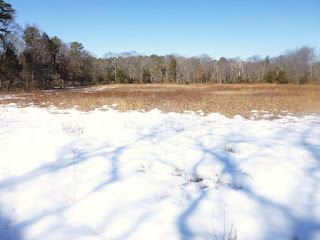 Daniel R. Davis Sanctuary
Daniel R. Davis SanctuaryLocation: Coram, NY
Size: 66 acres
Date of hike: March 22, 2015
Daniel R. Davis Sanctuary offers a secluded hike through pine barrens just a short distance from the hustle and bustle of Middle Country Road. I first stopped at the preserve last week, but I had to postpone my plans due to its unplowed parking area. We received an
absurd amount of snow this winter and it seems the region's smaller parks
didn't get much love from the plows. However, with warmer weather arriving, the snow had melted just enough for me to navigate the access road to Daniel R. Davis.
Before exploring, I learned more about the history and habitats of Daniel R. Davis Sanctuary. Apparently, the sanctuary came to be when the "last great ice sheet" retreated 8,000-10,000 years ago, causing melted water and strong winds to carry fine pulverized rock to the region, according to the Nature Conservancy's website. "The result was an acidic nutrient-poor soil that extends below the deepest tree root," the website said. "Since the rain drains quickly, the sanctuary is dry and has been scorched by wildfires over the years, with little plant life able to withstand its conditions." Interestingly, pitch pines produce flammable oils, waxes and resins that can help trigger fires as evidenced by the charred bark seen in some spots, according to the website. "Although few plants can withstand such challenging conditions, the distinctive pine barrens community of pitch pines, scrubby oaks, blueberries and other acid-loving plants flourish," the website said. As for the land, John Erhardt and his bother Charles donated 40 acres in 1964, with Daniel Davis Erhardt giving the final parcel in 1988.
Before exploring, I learned more about the history and habitats of Daniel R. Davis Sanctuary. Apparently, the sanctuary came to be when the "last great ice sheet" retreated 8,000-10,000 years ago, causing melted water and strong winds to carry fine pulverized rock to the region, according to the Nature Conservancy's website. "The result was an acidic nutrient-poor soil that extends below the deepest tree root," the website said. "Since the rain drains quickly, the sanctuary is dry and has been scorched by wildfires over the years, with little plant life able to withstand its conditions." Interestingly, pitch pines produce flammable oils, waxes and resins that can help trigger fires as evidenced by the charred bark seen in some spots, according to the website. "Although few plants can withstand such challenging conditions, the distinctive pine barrens community of pitch pines, scrubby oaks, blueberries and other acid-loving plants flourish," the website said. As for the land, John Erhardt and his bother Charles donated 40 acres in 1964, with Daniel Davis Erhardt giving the final parcel in 1988.
The sanctuary's entrance is located on Mount Sinai-Coram Road, just a stone's throw north of Middle Country Road (NY Route 25). However, please be aware that the entrance is set back off the street with a short access road leading to the small parking area, which is big enough to fit three cars. Upon parking, I noticed that there were no footprints in the snow, meaning I was the first person to have visited the preserve in at least a week. Pretty cool. Next, I stopped at a kiosk displaying a map of the sanctuary's trails, which consists of a small loop path with a second loop path that starts around halfway through the first loop. "The 1.4 mile worth of trails are open for hiking and observing nature from dawn to dusk," said the conservancy's website. "The sanctuary is a great place for hiking and exploring Long Island's glacial legacy and its rare and fascinating community of plants and animals."
The hike's highlights for me were the trees' charred barks and the dirt mounds where small mammals and reptiles shelter themselves from the fires. "Look for trees with charred bark, evidence of a recent fire," the conservancy's website said. "A severe fire will kill the upper branches, but only char (not burn) a pitch pine's thick insulating bark. If periodic wildfires didn't occur, tall oaks would take over and pine barren plants would not be able to survive." Also, look for reindeer moss on the forest floor, which have ashy gray stems that look like "little antlers," the website said. Another highlight was the boundary ditches made by 18 century settlers to mark their property lines before the invention of surveying instruments.
Regarding wildlife, you won't spot an abundance of bird life in the sanctuary. "Pine barrens lack the ecological variety necessary to support diverse bird populations," the website said. "However, this helps maintain the unique ecosystem – birds are important seed dispersers, and so their scarcity reduces the likelihood that any new plant species will be introduced." The lack of chirping compelled me to turn on my iPod. I selected Steven Wilson's 2015 concept album, Hand. Cannot. Erase., which is one of my favorite records of the year.
In closing, I'd definitely recommend a quick visit to the sanctuary if you live in the vicinity. The entire hike took an hour, which was the perfect length on this day. Typically, I prefer more diversity of habitats on my hikes, but the sanctuary succeeded in giving me a little escape into nature. And sometimes we all need an escape. We all need a sanctuary.
(Updated: Oct. 28, 2018)







Thanks! Here now. Very peaceful
ReplyDelete